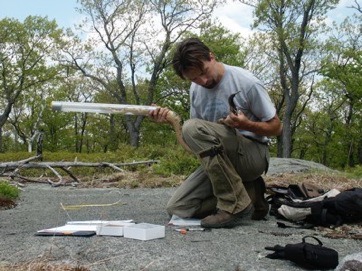
Research conducted by San Diego State doctoral students on the kangaroo rat, using high-speed cameras to demonstrate their ability to fight off predators, was recently featured in National Geographic.
Associate professor of ecology at SDSU Rulon Clark and associate professor of biology at UC Riverside Timothy Higham co-authored a pair of studies published in the Biological Journal of the Linnean Society and Functional Ecology. The professors advised a team led by doctoral candidates Malachi Whitford and Grace Freymiller, whose research explored the ability of kangaroo rats to evade rattlesnakes hunting in the desert near Yuma, Arizona.
Previous research into the kangaroo rat’s evasive maneuvers was conducted with lower frame rate cameras that captured their interaction with snakes. Researchers, however could not initially conclude what enabled the kangaroo rat to evade the hunting snakes.
“You couldn’t really see what was going on,” Whitford said. “You could see the kangaroo rat was coming into contact with the snake, but you were always left wondering why the kangaroo rat was still alive.”
Whitford and Freymiller led 30 field researchers into the Barry M. Goldwater Range in Yuma, between May and August of last year. The team implanted radio transmitters in snakes to track their movement, and when they began to hunt, the team deployed hundreds of pounds of high tech equipment — complete with high speed cameras, a camcorder and tripods — to record the interactions.
These high speed cameras helped Whitford and Freymiller discover the kangaroo rat’s complex ability to leap and spin in midair to avoid venomous snake bites. The cameras also revealed the kangaroo rat’s capacity to kick an attacking snake, an evasive maneuver that spared the rodent’s life more than half the time.
“We really didn’t expect to see the kangaroo rats kicking these snakes so vigorously,” Whitford said.
Modern technology enabled the team to record the interactions, and the recordings came as a surprise to the researchers.
“It was essential to have a camera that could record at 500 frames per second,” Freymiller said.
The team’s findings were recently featured in an April 5 article in National Geographic, highlighting the biological and ecological research currently conducted by SDSU students.
Whitford said the findings pave the way for future inquiry into predatory relationships. He said temperature plays a pivotal role in prey-predator interactions, since snakes are cold-blooded animals whose body temperature is affected by their surroundings. Because the warm-blooded kangaroo rat’s body temperature is not affected by the environment, Whitford said he plans to explore how climate change might affect this predatory relationship.
Clark’s research primarily explores predator-prey interactions. His other work currently focuses on “interactions between California ground squirrels and Northern Pacific rattlesnakes,” according to his website. He served as the project’s principal investigator and played a key role in guiding the team’s research.
“(He) guided us as his students through the process of collecting data and analyzing it, while providing feedback on the manuscript,” Freymiller said.
Higham also served as a principal investigator and his research at UCR focuses on biomechanics. Whitford said the relationship between behavioral ecology and biomechanics was instrumental to the project.
“Merging those two fields was a really good way of actually understanding how animals behave in the wild and how that behavior influences their survivorship,” Whitford said. “It was a really cool collaboration.”
Clark’s website also highlights his work “collaborating with (his) graduate students” on their various research projects. Freymiller said his passion for research helps students looking to acquire experience in the field.
“Dr. Clark has a really good track record of hiring undergraduates to help with research in his lab,” she said. “He is really helpful in guiding and introducing them to field research.”






